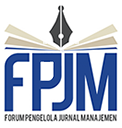PENGARUH INSENTIF DAN PEMANTAUAN : DAMPAK TERHADAP ORIENTASI KEUANGAN DAN NON-KEUANGAN DALAM PENGANGGARAN MODAL
DOI:
https://doi.org/10.33633/jpeb.v4i2.2499Abstract
This research aimed to investigate the influence of incentive and monitoring provided to the decision maker that impacted on finance and non-finance orientation in budget planning. The independent variable in this study was incentive and monitoring in budget planning focusing on the project recommendation selection. While the dependent variable was finance and non-finance orientation in budget planning. The research employed an experimental method using descriptive statistics analysis applying a case study approach. The analysis involved multinomial logistics regression using a statistics computer application. The result of this study indicated that the decision maker did not provide significant evidence that s/he made a high emphasis on the finance and non-finance orientation without incentive and monitoring. However, the decision maker receiving private incentive emphasized highly on cash inflows and a low emphasis on cash outflows, or vice versa. Keywords: budget planning, project selection, finance orientation, non-finance orientation, private incentive, monitoring.References
Bennuona, K., Meredith, GG, & Merchant, T. (2010).Improved capital budgeting decision making: Evidence from Canada. Management Decision, 48(2), 225-247.
Brigham Eugene E dan Houston, Joei F. 2012. Dasar-Dasar Manajemen Keuangan .Edisi 11.Alih bahasa Ali Akbar Yulianto. Jakarta: Salemba Empat.
Brown, C. E., & Solomon, I. (1993).An experimental investigation of explanations for outcome effects on appraisals of capital budgeting decisions. Contemporary Accounting Research, 10(1), 83-111.
Burns, R. M., & Walker, J. (2009).Capital Budgeting surveys: The future is now. Journal of Applied Finance, 19(1/2), 78-90.
Butler, R., Davis, L., Pike, R., & Sharp, J. (1993).Strategic Investment Decisions: Theory, Practice, and Process. London, England: Routledge.
Canteralli, C. C., Flyvbjerg, B., Molin, E. J. E., & van Wee, B. (2008). Cost overruns in large-scale transportation infrastructure projects: explanations and their theoretical embeddedness. European Journal of Transport Infrastructure Reasearch, 10(1), 5-18.
Carr, C., & Tomkins, C. (1998).Context, culture and the role of the finance function in strategic decisions: a comparative analysis of Britain, Germany, the USA and Japan. Management Accounting Research, 9(1), 213-239.
Chen, S. (2008). DCF techniques and nonfinancial measures in capital budgeting: a contingency approach analysis. Behavioral Research in Accounting, 20(1), 13-29.
Cheng, M. M., & Mahama, H. (2011).The impact of capital proposal guidelines and perceived preparer biases on reviewers’ investment evaluation decisions. Australian Journal of Management, 36(3), 349-370.
Cheng, M. M., Schulz, A. K. D., Luckett, P. F., & Booth, P. (2003).The effects of hurdle rates on the level of escalation of commitment in capital budgeting. Behavioral Research in Accounting, 15(1), 63-86.
Chenhall, R. H., & Morris, D. (1993).The role of post completion audits, managerial learning, environmental uncertainty and performance. Behavioral Research in Accounting, 5(1), 170-186.
Davis, J.H., Schoorman, F.D. and Donaldson, L. (1997), “Toward a stewardship theory of managementâ€, Academy of Management Review, Vol. 22 No. 1, pp. 20-47.
Dayananda, D., Irons, R., Harrison, S., Herbohn, J. and Rowland, P. (2002), Capital Budgeting: Financial Appraisal of Investment Projects, Cambridge University Press, Edinburgh.
Efrilna, Putri. (2018). Pengaruh Skema Pemberian Insentif dan Tanggung Jawab Personal Terhadap Budgetary Slack. Jurnal Riset Akuntansi. Universitas Negeri Padang.
English, T. (2001). Tension analysis in international organizations: A tool for breaking down communication barriers. The International Journal of Organizational Analysis, 9(1), 58-83.
Frezatti, F., de Souza Bido, D., Da Cruz, A. P. C., Barroso, M. F. G., & de Camargo Machado, M. J. (2013).Investment decisions on long-term assets: integrating strategic and financial perspectives. European Accounting Review, 22(2), 297-336.
Ghozali, Imam. (2018). Aplikasi Analisis Multivariate Dengan Program IBM SPSS 25.Fakultas Ekonomika dan Biania Universitas Diponegoro Semarang. Penerbit: Undip.
Guilding, C. (2003). Hotel owner/operator structures: implications for capital budgeting process. Management Accounting Research, 14(3), 179-199.
Gordon, L. A., & Pinches, G. (1984).Improving Capital Budgeting: A Decision Support System Approach. Reading, Mass.: Addison-Wesley.
Haka, S. F. (2007).A Review of the Literature on Capital Budgeting and Investment Appraisal: Past, Present, and Future Musings. In C. Chapman, A. G. Hopwood & M. D. Shields (Eds.), Handbook of Management Accounting Research (Vol. 2, pp. 697728). New York, NY: Elsevier.
Handoko, T.Hani. (2000). Manajemen Personalia dan Sumberdaya Manusia. Yogyakarta:Penerbit BPFE.
Hensher, D. A., Rose, J. M., & Greene, W. H. (2005). Applied Choice Analysis: A Primer. Cambridge, England: Cambridge University Press.
Hiebl, MRW (2015), Agency and Stewardship Attitudes of Chief Financial Officers in Private Companies.Vol. 7 Iss 1, pp 4-23.
Hosmer, D.W., and Lemeshow, S. (1989). Applied Logistic Regression. John Willey, New York.
ISHC.(2015). CapEx2014.A Study of Capital Expenditures in the Hotel Industry (pp. 1243). Lansing, MI: American Hotel & Lodging Educational Institute.
Jensen, M., & Meckling, W. 1976.Theory of The Firm: Managerial Behavior Agency Cost, and Ownership Structure. Journal of Finance Economics3, 305 – 360.
Kariuki. 2010. Budgeting: A Fundamental Management Tool. Volume 1. Kasneb Newsline. hlm. 4.
Kadous, K., Koonce, L., & Towry, K. L. (2005).Qualification and persuasion in managerial judgement.Contemporary Accounting Research, 22(3), 643-686.
Kengatharan, M. N. L. (2015). Capital budgeting practices: evidence from Sri Lanka. Journal of Advances in Management Research, Vol. 12 Iss 1 pp. 55 – 82.
Kerler III, W. A., Fleming, A. S., & Allport, C. D. (2014).How Framed Information and Justification Impact Capital Budgeting Decisions. In M. J. Epstein & J. Y. Lee (Eds.), Advances in Management Accounting (Vol. 23, pp. 181-210). Emerald Group Publishing Limited.
Khalil & O ’sullivan, (2017).Meditari Accounting Research: Incentives and monitoring: impact on the financial and non-financial orientation of capital budgeting. Emerald Group Publishing Limited.
Koch, B., Mayper, A. G., & Wilner, N. (2009).The interaction of accountability and postcompletion audits on capital budgeting decisions. Academy of Accounting and Financial Studies Journal, 13(Special Issue), 1-27.
Lima, A. C. Silveira, J. A. G. Matos, F. R. N. & Xavier, A. M. (2017).A qualitative analysis of capital budgeting in cotton ginning plants.Qualitative Research in Accounting & Management.Vol. 0 Iss ja pp. 00-00.
Lubis, A. I. (2013). Akuntansi Keperilakuan: Akuntansi Multiparadigma. Edisi ketiga. Jakarta. Salemba Empat.
Luce, M. F. (1998). Choosing to avoid: coping with negatively emotion-laden consumer decisions. Journal of Consumer Research, 24(4), 409-433.
Merchant, Kanneth A. &Van der Stade, Wim A. 2014 . Management control systems. Edisi ketiga. Jakarta: Salemba Empat.
Mukherjee, T. K. (1987). Capital-budgeting surveys: The past and the future. Review of Business and Economic Research, 22(2), 37-56.
Netter, J., Kutner, M.H., Nachtseim, C.J and Wasserman, W. (1996).AppliedLinear Statistical Models.Fourth edition. The McGraw-Hill Companies,Inc., United States of America.
Otley, David T. 1980. The Contigency Theory of Management Accounting: Achievement and Prognosis. Accounting Organization and Society.Vol. 5. Hlm. 413-428.
Porwal, L. S., & Singhvi, S. S. (1978).A comparative study of capital expenditure evaluation techniques. Long Range Planning, 11(5), 25-31.
Quirin, G.D. (1967), The capital expenditure decision. Irwin, RD.
Riyanto, Bambang. (2015). Dasar-Dasar Pembelanjaan Perusahaan. Edisi Keempat. Yogyakarta, BPFE.
Segelod, E. (1998), Capital budgeting in a fast-changing world, Long Range Planning, Vol. 31 No. 4, pp. 529-541.
Suadana, I Made. (2011). Manajemen Keuangan Perusahaan Teori & Praktek.Erlangga. Jakarta.
Swain, M. R., & Haka, S. F. (2000).Effects of information load on capital budgeting decisions. Behavioral Research in Accounting, 12, 171.
Triastuti, Ningsih, & Diba, (2018), Analisis Capital Budgeting Dalam Meningkatkan Keputusan Investasi Pada Pt. Samudera Indonesia. Jurnal Riset Akuntansi Paradigma, 5(1).
Utomo, Setyo. (2009).Model Regresi Logistik Untuk Menunjukkan Pengaruh Pendapatan Per Kapita, Tingkat Pendidikan, Dan Status Pekerjaan Terhadap Status Gizi Masyarakat Kota Surakarta.
Van Horne, J.C, & Wachiwicz.(2008). Fundamental of Financial Management.Salemba. Jakarta.
Wagner III, J. A., & Gooding, R. Z. (1997).Equivocal information and attribution: an investigation of patterns of managerial sensemaking. Strategic Management Journal, 18(4), 275-286.
Waldron, M., & Fisher, R. (2017).Values and ethical judgments: the adequacy of students as surrogates for professional accountants. Meditari Accountancy Research, 25(1), 3764.
Zeelenberg, M., Inman, J. J., & Pieters, R. (2001).What We Do When Decisions Go Awry: Behavioral Consequences of Experienced Regret. In E. U. Weber, J. Baron & G. Loomes (Eds.), Conflict and Tradeoffs in Decision Making (pp. 136-155). Cambridge, UK: Cambridge University Pres
Downloads
Published
How to Cite
Issue
Section
License
The copyright of the received article shall be assigned to the journal as the publisher of the journal. The intended copyright includes the right to publish the article in various forms (including reprints). The journal maintains the publishing rights to the published articles.
This work is licensed under a Creative Commons Attribution 4.0 International License.



.png)











